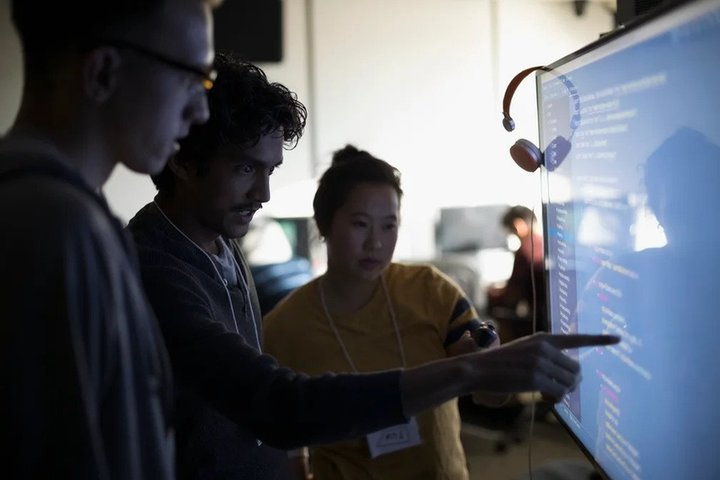Information Advantage and Defence Intelligence

FOREWORD
The conflict in Ukraine has shocked and appalled people around the world, and challenged the views of those who long-thought conflict between two European nations was a thing of the past.
To those in defence and military circles, the conflict has clearly underlined the importance of strong and advanced military capabilities in Western nations to effectively handle conflict.
Conflict has changed dramatically. It has broadened across the globe. Resources needed to address it have been increased and refined. And crucially, it has become a much more blurred concept than it was several decades ago.
In the past, there were states – now there are organisations capable of waging conflict. Historically, conflict occurred in ‘wartime’ now, we are in a constant state of ‘political warfare’ with those looking to undermine the international order.
Most importantly before intelligence and information advantage the success of military operations relied on traditional sources. Now, it is an exponentially growing space – both public and private, open and closed source, which militaries and Defence must wade through to find critical nuggets of information.
This, therefore, outlines the next great challenge for Defence in future military operations; to develop the most effective ways to review and understand reams of information, and to quickly identify what information is crucial to operational success.
This is especially so given the domains conflicts can be fought over, and the sophistication of conflict in each of these domains, has grown creating even greater potential for an information advantage to take shape.
The one positive facing Defence – despite conflict becoming more present, more ambiguous and more complex – is that advances in technology can help level the playing field, and help militaries operate effectively in these new grey zones.
And specifically with intelligence, stronger collaboration between state and industry may well yield the answer. Industry’s natural focus on delivering innovation means it can be the growth partner for Defence in determining how it can truly harness all the information now at its disposal. The Government’s ability to use industry’s innovative streak will be correlative to Government’s success in delivering an operational edge through intelligence.
The above all underlines the timeliness and importance of Paul Rimmer’s paper, Information Advantage and Defence Intelligence. It outlines how industry and Defence can work together to combat this hurdle, and ultimately how UK Defence can harness a huge opportunity in developing a clear strategic advantage for conflicts to come. At a time when conflict has been thrust back to the top of the political agenda in Whitehall and other Governments across the world, the course that Rimmer’s paper sets is more important than ever.

Al Potter
VICE PRESIDENT & MANAGING DIRECTOR NATIONAL SECURITY & DEFENCE DIVISION, LEIDOS UK

ABOUT THE AUTHOR
A former Senior Civil Servant in the Ministry of Defence and Deputy Chief of Defence Intelligence until May 2020, Paul Rimmer brings 37 years’ experience of operating at the heart of the UK’s national security business. An experienced intelligence analyst and Head of Profession for intelligence analysts in Defence, he was a member of the Joint Intelligence Committee for nearly 13 years. He has also been a customer for intelligence in jobs ranging from Principal Private Secretary to two Defence Secretaries to being the senior civilian at the Permanent Joint Headquarters, Northwood. Paul is now an independent consultant, advising Leidos, as well as a Senior Adviser at the International Institute for Strategic Studies and a Visiting Professor at King’s College, London.


INTRODUCTION
The worlds of defence and technology come together in many ways, but perhaps no more so than in their love of buzzwords and arcane terminology. Whether it’s ‘artificial intelligence (AI)’, ‘grey zone’ or ‘multi-domain integration’, it can be all too easy to get caught up in the jargon and to forget the ultimate objective, which in defence terms is to deter or defeat an adversary. This was underlined in two papers published by the UK Government in March 2021: Global Britain in a Competitive Age: the Integrated Review of Security, Defence, Development and Foreign Policy, and Defence in a Competitive Age. They described a world in which four trends were seen to be becoming dominant: great power competition, including that between democratic and authoritarian values and systems of government, the growing importance of the Indo-Pacific region, rapid technological change and significant transnational challenges requiring collective action (such as climate change and terrorism). Tackling all of these issues needs technology to help to give us an edge, but it needs to be directed and focused – we need to get behind the buzzwords if we are to deliver real advantage to decision-makers and operators.
Both papers were built in part on MOD’s ‘Integrated Operating Concept’, published in August 2020. This opens with a description of the challenge being faced:
The strategic context is increasingly complex, dynamic and competitive. We live in an era of strategic competition in which long-held assumptions are challenged daily. Old distinctions between ‘peace’ and ‘war’, between ‘public’ and ‘private’, between ‘foreign’ and ‘domestic’ and between ‘state’ and ‘non-state’ are increasingly out of date. Our authoritarian rivals see the strategic context as a continuous struggle in which non-military and military instruments are used unconstrained by any distinction between peace and war. These regimes believe that they are already engaged in an intense form of conflict that is predominantly political rather than military. Their strategy of ‘political warfare’ is designed to undermine cohesion, to erode economic, political and social resilience, and to compete for strategic advantage in key regions of the world.
It is really important to understand this perspective, as this complex challenge is at the heart of the requirement for a new and more dynamic relationship between MOD and industry. A relationship that urgently needs putting into practice.

INTELLIGENCE AND MULTI-DOMAIN INTEGRATION
Both the 2021 Government papers were in part notable for the prominence they gave to some lesser-known parts of Defence: Defence Intelligence and the Command of which it is a part, UK Strategic Command. Defence Intelligence, unusually, has its own section in the Defence paper, in a chapter titled ‘Transforming our ways of working’. It is clearly seen as playing a critical part in developing ‘understanding’ and ensuring the passage of information quickly and securely across all five domains (land, sea, air, space and cyber) and at a variety of security classifications. But there is also recognition that it needs significant development in order to succeed: “Open source intelligence, automation and AI provide potentially game-changing ways to understand and counter these new challenges”. Similarly, the key role of Strategic Command is emphasised: “at the heart of confronting the myriad threats we now face. Driving integration across all domains“ together with its responsibility for delivering some challenging projects including in the realms of cyber and technology, such as a ‘Digital Backbone’ providing the digital infrastructure to share and exploit data and enable multi-domain integration.
At DSEI in 2021, speeches by the commanders of these two organisations developed these themes and shed further light on their perception both of the challenges and what lies behind the buzzwords. Gen Sir Patrick Sanders, Commander UK Strategic Command, asked why we should care about multi-domain integration and answered with one word: ‘threat’. He highlighted authoritarian great power behaviour that sought to win without fighting (i.e. operating in the ‘grey zone’), the expansion of warfare into the new domains of space and cyber and a race to exploit and dominate the frontiers of technology, from artificial intelligence to quantum computing, to autonomous systems and future telecommunications. He described operating, and winning, across these various domains being what multi-domain integration is all about. This could range from understanding and persuading audiences through social media tools to the delivery of effective military strikes through effective exploitation of masses of data that is freely available. But to deliver this, he also challenged the UK armed forces’ culture, which is still founded on three individual Services, with ‘joint’ education only emerging from mid-career. He coined the term ‘penta-phibians’, the need to evolve personnel comfortable at operating across all five domains with the consequent training and education to get them there.

Lt Gen Sir Jim Hockenhull, Chief of Defence Intelligence (and recently announced as General Sanders’ successor, where he will be able to continue to champion this thinking), built on some of this in his speech, describing Defence Intelligence’s role as providing the foundations upon which multi-domain integration is built. That requires an ability to operate broadly, both geographically and in all five domains, as well as in a more complex, cross-government environment. Critically, in that competition for knowledge and understanding, he emphasised the need for Defence Intelligence to operate at pace in order to match the capabilities of adversaries. Whilst acknowledging that highly classified intelligence was still important in developing understanding, he warned that serious exploitation of publicly available, or open source, information was still in its relative infancy. Only by combining the two at scale, developing automation and freeing up the human analyst from menial tasks better suited to computers, can real progress be made to get ahead of an adversary’s thinking. To achieve this, Hockenhull highlighted the need for access to data of all sorts and expertise from the commercial sector to help to build open-source tools. But that would also require genuine integration across low- and high-side classification systems if the best information is to be effectively brought together and delivered to decision-makers in time to make a difference.

THE REALITY
Some of this has been brought into sharp focus in recent weeks by the Russia/Ukraine crisis. The build-up of Russian forces on Ukraine’s borders was highly visible and not just to the intelligence Agencies of the US, UK and other NATO countries. Whilst part of the Russian strategy before its invasion was to overtly emphasise its military power, the information available to think-tanks and ‘citizen analysts’ – largely via commercial satellite imagery –showed a quite remarkable step-change from a generation ago when such images were the sole preserve of intelligence organisations with access to sophisticated and highly classified defence technology. Not restricted to the more obvious indicators, such as pictures of tanks and other armoured vehicles, analysis of commercial satellite photography showed the presence of field hospitals, the movement of vehicles through snow and even assessments of whether tents were occupied (through snow melting rather than remaining on them). This enabled the likes of the US and UK to use this material to brief on Russian dispositions without endangering sensitive sources or being accused of exaggeration. But those Governments went a step further, deploying insights from secret intelligence sources too (such as potential dates for a Russian invasion or that it would be preceded by a staged incident), all with the aim of wrong-footing the Russians and hopefully deterring them from using military force.

Ultimately, of course, Putin was not deterred from mounting his invasion. But that use of intelligence and open-source information may indeed have had an impact, contributing perhaps to the confusion and miscalculation that has been only too evident in the Russian action. And that combined use of intelligence and open source has continued during the conflict, to describe the progress of the fighting, and to expose Russian planning and failings – including to its own people, starved of truthful information by its own government. Altogether, this demonstrates the kind of multi-domain integration approach in the ‘grey zone’ that General Sanders described.


THE FUTURE
But, whilst an important development, this is really just raising the corner of a curtain rather than viewing the entire landscape compared with the potential benefits from truly effective exploitation of open-source data from a multitude of sources, combined with the ability to integrate that material with secret intelligence. Even that is not the end of the story. That data then needs to be presented in a way that it can be taken on by—rather than just overwhelm—the human analyst, who can add their experience, analytical expertise and, perhaps, human scepticism and questioning, to the process. Finally, the analyst needs to be able to present their conclusions clearly and concisely to the decision-maker, whether in London or deployed overseas, on land, sea or in the air or operating in cyberspace or drawing on space-based systems. When all of these elements come together at pace, only then will we be able to claim that true multi-domain integration really has meaning.

To achieve that kind of pace and scale, both Generals Sanders and Hockenhull stressed the need for defence to develop a different relationship with industry, to recognise that industry is leading innovative technological change and that the, often slow, processes of government have to adapt if it is not going to be left behind. Indeed, a theme repeated throughout the Integrated Review is the need for Government and industry to work together in the interests of the country’s security. Sanders commented that the common image of the defence sector is represented by aircraft carriers and fighter jets, but in this world of multi-domain integration, software tools, cloud computing and data are as real, if more intangible, than traditional hardware.
So, what does this mean for Leidos? Well, it means developing that genuine partnership with the Ministry of Defence as outlined by both Generals and the Government’s strategy. A partnership in which we truly understand MOD’s needs and can both anticipate and respond – at pace – with flexible tools that can be integrated into existing IT systems, can be easily updated and work across all five domains and all security classifications. Of course, a partnership takes two and the Integrated Review, whilst generally encouraging in this respect, was light on the practicalities. So MOD needs to be prepared to update its procurement processes, be comfortable with trying things that fail early, but can be replaced quickly and to think imaginatively about the services it needs and is prepared to accept from industry. In his foreword to the Defence Command Paper, the Defence Secretary says that its success “should not be judged on the sophistication of all the words that follow but our implementation of its reforms. And, ultimately, on the delivery of its capabilities into the hands of the men and women of our armed forces.” None of this is a small challenge, neither is it out of the question, but only through true partnership is it likely to get close to realisation.

Find out more
Learn about Leidos in the UK
